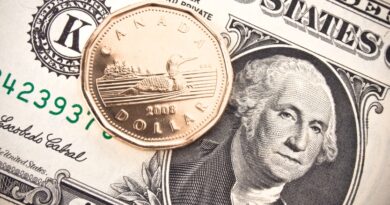Riding the Currency Waves: How Interest Rates Shape the USD to CAD Exchange Rate
In the world of international finance, where currencies traverse global borders like seasoned jet-setters, one force reigns supreme in dictating the ebb and flow of exchange rates: interest rates. Today, we embark on a voyage through the currency markets to explore the fascinating interplay between interest rates and the USD to CAD exchange rate.
Picture this: you’re sipping your morning coffee in Toronto, musing about the whims of the currency market while staring out at the CN Tower, wondering why the US dollar (USD) to Canadian dollar (CAD) exchange rate seems to have a mind of its own. Well, my friend, you’re not alone. Let’s embark on a journey to uncover the secrets behind these fluctuations and the role that interest rates play in this ever-evolving financial tango.
The Exchange Rate Dance
Before we dive into the nitty-gritty of interest rates, let’s set the stage. The exchange rate between the USD and CAD is like a dynamic dance between two partners. One partner, the USD, is a heavyweight global currency with far-reaching influence, while the other, the CAD, is a resource-driven currency with its own set of charms.
Much like a dance, the exchange rate can be influenced by various factors, including economic indicators, geopolitical events, and yes, you guessed it, interest rates. Let’s explore how interest rates play their role in this intricate performance.

Interest Rates – The Conductor’s Baton
Interest rates, in the world of finance, are like the conductor’s baton in an orchestra. They set the tempo and rhythm of the market, influencing the behavior of investors, traders, and governments. In essence, they determine the cost of borrowing and the rewards for saving and investing. So, how do these rates impact the USD to CAD exchange rate?
When the United States Federal Reserve (the Fed) adjusts interest rates, it sends ripples throughout the financial world. If the Fed raises interest rates, it becomes more attractive for investors to park their money in US assets, leading to an increased demand for the USD. Consequently, the USD strengthens against other currencies, including the CAD.
On the flip side, when the Fed lowers interest rates, the CAD can become a more appealing option for investors seeking higher yields. This shift in demand can lead to a weakening of the USD relative to the CAD.
The Interest Rate Differential
Now, here’s where the plot thickens: the interest rate differential. This is the key factor in understanding how changes in interest rates impact the USD to CAD exchange rate.
Imagine that the Fed raises interest rates while the Bank of Canada (BoC) keeps its rates steady. This creates a situation where US assets offer higher returns than their Canadian counterparts. Investors will flock to the US market, driving up demand for the USD and pushing the exchange rate higher. This scenario is favorable for USD holders but not so much for CAD holders.
On the other hand, if the BoC raises interest rates while the Fed keeps its rates unchanged, the interest rate differential favors the CAD. Investors seeking higher yields will turn their attention to Canadian assets, causing the CAD to appreciate against the USD.
Unpredictable Partners
Now, here’s where the exchange rate dance gets tricky: market expectations and unpredictability. The forex market is a complex and highly speculative arena where traders attempt to predict the future movement of currencies based on a multitude of factors, including economic data, political events, and, you guessed it, interest rate decisions.
It’s often said that the forex market has a mind of its own, and it can be a real challenge to predict its next move. Just when you think you’ve got it all figured out, it can throw a curveball. This unpredictability can be attributed to the intricate interplay of factors beyond interest rates, such as trade tensions, global economic conditions, and even the occasional tweet from world leaders.
Recent USD to CAD Fluctuations
To bring the concept of interest rates’ impact on the USD to CAD exchange rate into sharper focus, let’s take a look at some recent real-world scenarios.
In 2018, the USD to CAD exchange rate experienced significant fluctuations. The Fed was raising interest rates in response to a strengthening US economy, while the BoC was gradually following suit but at a more cautious pace. This led to a substantial interest rate differential, favoring the USD.
Consequently, the USD appreciated against the CAD, with the exchange rate climbing to levels not seen in years. This made traveling south of the border more expensive for Canadians and had implications for businesses engaged in cross-border trade.
However, the situation started to shift in 2019. As global economic uncertainties loomed, the Fed began to adopt a more dovish stance, indicating a halt in interest rate hikes. Meanwhile, the BoC maintained its cautious approach. This shift in the interest rate narrative contributed to a stronger CAD, as investors sought higher yields north of the border.
As we venture into 2020 and beyond, the exchange rate story continues to evolve, demonstrating how interest rates remain a prominent force in shaping the USD to CAD exchange rate.
Beyond Interest Rates – A Joke to Lighten the Mood
Now, let’s take a brief detour from the world of finance for a moment with a little currency-related humor:
Why did the Canadian dollar go to therapy?
Because it had too many issues with its American counterpart!
Okay, back to business.
Managing Exchange Rate Risk
For businesses and investors involved in cross-border trade or investments, managing exchange rate risk is paramount. The fluctuations in the USD to CAD exchange rate can have a substantial impact on the bottom line. So, what can they do to navigate these waters?
One common strategy is hedging. Hedging involves using financial instruments like forward contracts or options to protect against adverse exchange rate movements. For instance, a Canadian exporter selling goods to the United States might use a forward contract to lock in a specific exchange rate for future transactions, safeguarding against potential CAD depreciation.
Another approach is diversification. Investors can spread their portfolios across different currencies and asset classes, reducing their exposure to any single currency’s fluctuations. This strategy can help mitigate risk and minimize the impact of interest rate-driven exchange rate movements.
The Future of Interest Rates and Exchange Rates
As we look ahead, the relationship between interest rates and the USD to CAD exchange rate is bound to continue evolving. The world of finance is dynamic, influenced by a wide array of factors, and is often subject to unforeseen events. However, some key trends and considerations can be anticipated.
Firstly, the actions of central banks, particularly the Fed and the BoC, will remain central to the interest rate narrative. The timing and magnitude of interest rate changes will continue to affect the interest rate differential and, subsequently, the exchange rate.
Secondly, global economic conditions will play a pivotal role. As the world emerges from the economic fallout of the COVID-19 pandemic, the path to recovery, inflation rates, and international trade dynamics will all shape the future of the USD to CAD exchange rate.
Lastly, geopolitical events and trade tensions can’t be underestimated. These factors have the potential to disrupt even the most carefully laid interest rate forecasts and can send shockwaves through the currency markets.


